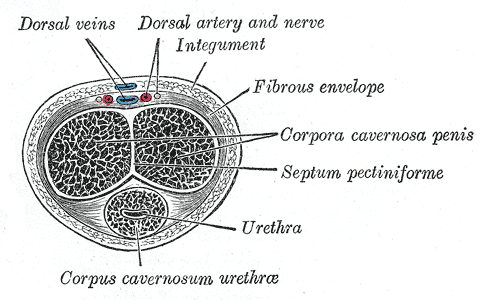Your spam folder is probably full of the offers. (Mine certainly is.) But none of the emails promising to let you “please your partner” by making you a “giant for girls” with “strong erections” say a thing about how the penis gets erect in the first place. Here’s how it really works.
Picture: Dr Horrible’s Sing-Along Blog
First of all, let’s acknowledge that the process depends on healthy tissues and a complex interplay of neural signals, interweaving the responses of, to use a car analogy, the nervous system’s analogs of accelerator and brake with a whole suite of competing signals inside the brain. It’s a dance that sometimes leads to mixed signals, and although it’s fascinating, I’m not going to cover that here. From here on in, simply assume that the penis is healthy and all the signals it’s getting from the brain say “Go!”
A Penis Anatomy Primer

There are actually three erectile structures inside a human penis. One, called the corpus spongiosum, runs along the bottom of the organ from base to tip, where it spreads out to form the glans. The urethra runs through it (inspiring its name in older papers, the corpus cavernosum urethrae), and although the corpus spongiosum engorges with blood during erection, it doesn’t do much to make the penis stiff. That job belongs to the two erectile structures on the upper side of the penis, the corpora cavernosa.
The corpora cavernosa are like conjoined twins: they run side-by-side down the length of the penis, fused together where they touch. But while the tissue around the outside of the corpora is leak-proof, the wall between them is more like a beaded curtain, with tons of openings that let blood flow freely between the two sides. Near the base of the penis, each corpus cavernosum flares away from its twin, forming a pair of “legs” that tie themselves firmly to the pelvis. This anchor gives the penis a solid base to resist all that rhythmic pushing that happens during sex. The arteries that supply the blood for erection enter the corpora cavernosa here, slipping in at the back away from all the action.

Each corpus cavernosum is a hollow tube, its center filled with a spongy network of open spaces, smooth muscle, and small arteries. The central spaces fill with blood during erection, which might make you think they’re the most important part of the enterprise — these are, after all, the tissues that drugs like Viagra target. But you’d be ignoring another, equally important element. Blood, by itself, can’t raise anything’s pressure: it needs to push against something. And the only thing it can push against is the corpora’s thick outer wall.
The wall of the corpora cavernosa, called the tunica albuginea, isn’t your average sheet of connective tissue. Like other connective tissues that surround and separate organs, it’s mostly made of a protein called collagen. But in each layer of the tunica albuginea, those collagen fibres are densely packed and highly organised. Rather than pointing any which way, each strand of collagen lies stacked next to its neighbours, as orderly as the pasta inside a box of spaghetti.
Primed for Action
A penis stays flaccid as long as the smooth muscles inside the vascular spaces are contracted. Contracted muscles keep the tiny arteries inside the erectile tissue squeezed shut, making blood move at a trickle instead of a flow. The lack of blood keeps blood pressure inside the cavernous space low — lower than the average blood pressure in arteries throughout the rest of the body. And as long as the volume of blood moving through the space stays small, there’s not enough inside the organ to really push on the tunica wall.
While the wall is relaxed, it’s bunched up like a wadded up sock. The collagen fibres inside the wall are folded up, too — each fibre looking a bit like a strip of accordion- folded paper. The combination of low blood volume and loose, bunchy tissue gives the penis its “flaccid” character: flexible, a bit stretchy, and considerably smaller than when it’s deployed for sex.
Rapid Deployment
Everything changes when the brain flips on ‘arousal.’ The signal that told smooth muscle to squeeze down vanishes, arteries open up, and blood rushes into the central cavernous spaces, eager to equalise the pressure difference between penis and body. As blood enters, it fills the available space and starts to push on the wall.
The wall doesn’t push back. Instead, it stretches as the collagen fibres inside of it expand and unfold. As the tunica albuginea expands outward, it squeezes off the drainage veins that leave the corpora cavernosa, trapping blood inside and increasing the penis’s length and girth.
Brake for Erection
Obviously, this process doesn’t go on forever. There’s a stop point, a stable size where the penis will max out its growth. That point comes when the collagen fibres in the wall fully unfold.
A collagen fibre is like a steel cable; if you pull on its ends, it will resist (and transmit) that force. And like steel, collagen is very stiff when it’s fully loaded. So while the folded collagen fibres inside the wall didn’t resist the push of blood filling the penis, once all those folds are gone the extended collagen fibres act like a brake. The wall tissue rapidly becomes very stiff, stops expanding, and pushes back if more blood tries to enter the central space. With no more space to fill, blood pressure inside the corpora rises to match the blood pressure of the rest of the body. Since all of the spaces in both corpora cavernosa are interconnected (remember the beaded curtain?), the pressure inside every part of the structure rises together, making the penis stiffen as a single unit.
And now it’s ready for action.
(I will note that this is probably also how the clitoris gets erect — penis and clitoris are homologous tissues!)
Pictures: Grey’s Anatomy of the Human Body 1918
[Wagner 1981, Hanyu et al. 1987, Andersson and Wagner 1995, Kelly 1999]
